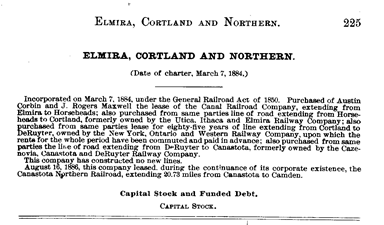May 08, 2005
Looking in on the Elmira, Cortland, and Northern, 1891-2
After seeing some of the collectibles at last month's railfair, I went looking around eBay. I didn't find any stunning lanterns or other original memorabilia, but I did find (reasonably priced!) financial reports for the Elmira, Cortland, and Northern for 1891 and 1891. Sadly, they're ripped out of an old compendium of reports, but they're still a fascinating window into the past.

The Elmira, Cortland and Northern's 1892 introduction
The Elmira, Cortland and Northern ran from Elmira to Camden, NY by way of Cortland. In the Town of Dryden, it ran from Game Farm Road opposite the present East Ithaca Recreation Way to Varna, Etna, Freeville (where it crossed the Southern Central), and McLean. In 1895 it became part of the Lehigh Valley Railroad, where it remained until the line's abandonment in the 1970s.
I can't say I find most modern annual reports exciting reading, but there are some interesting pieces here, especially because the reports provide some detailed breakdowns of expenditures. A freight house at Freeville cost $673.33 in 1891, while a new boxcar built in 1892 cost $666.80. Operating expenses include things like "Repairs of bridges (including culverts and cattle-guards)," "Wages of conductors and men," "Damage to cattle and property," and "Telegraph maintenance and operation." The average rate for carrying passengers per mile in 1891 was 2.39¢, while the average rate for freight per mile was .75¢.
Each of the years lists through and local passengers and freight, as well as total passenger miles and total passenger freight. Assembling them, we can see:
| Through | Local | Total | % Local | |
|---|---|---|---|---|
| Number of Passengers, 1891 | 36,078 | 219,374 | 255,452 | 85.8% |
| Number of Passengers, 1892 | 48,543 | 212,170 | 260,713 | 81.3% |
| Tons of Freight, 1891 | 422,937 | 61,898 | 484,835 | 12.8% |
| Tons of Freight, 1892 | 256,992 | 67,501 | 324,493 | 20.8% |
Passenger traffic was heavily weighted toward local traffic, while freight traffic was heavily weighted toward through traffic. And what was all that freight traffic?
| Item | 1891 | 1892 |
|---|---|---|
| Flour | 0.75% | 1.7% |
| Grain | 1.92% | 2.3% |
| Meats and Provisions | 2.01% | 3.1% |
| Live stock | 0.25% | 0.4% |
| Lumber | 5.57% | 7.2% |
| Pig and bar iron and steel | 0.97% | 1.5% |
| Iron or other ores | 2.74% | 1.1% |
| Coal and coke | 70.06% | 51.1% |
| Petroleum and other oils | 0.36% | 5.0% |
| NYS manufactured goods | 4.93% | 9.7% |
| Other manufactured goods | 2.04% | 3.1% |
| Other merchandise | 1.42% | 3.1% |
| Other agricultural products | 2.59% | 5.8% |
| All other articles | 4.39% | 9.4% |
The numbers for coal fall even more drastically than the drop in freight overall from 1891's 339,677 tons to 1892's 165,850. There isn't much information here about why, but it probably didn't make the railroad's owners - all 25 stockholders - very happy. It's also interesting to see that the two Ithaca members of the Board of Directors in 1891, Franklin C. Cornell and Frank J. Enz, disappear in 1892, when the entire Board is made of of downstate residents, plus one person in Greenwich, Connecticut and another in Philadelphia.
If you'd like to look at these more closely, I've scanned them in and posted them as PDFs:
- 1891 Report, clearer (350KB PDF)
- 1891 Report, selectable (664KB PDF)
- 1892 Report, clearer (333KB PDF)
- 1892 Report, selectable (761KB PDF)
The selectable versions aren't great, as the font and the age-darkened paper didn't lend themselves to clean optical character recognition, but they may still be useful.
Posted by simonstl at May 8, 2005 05:11 PMNote on photos